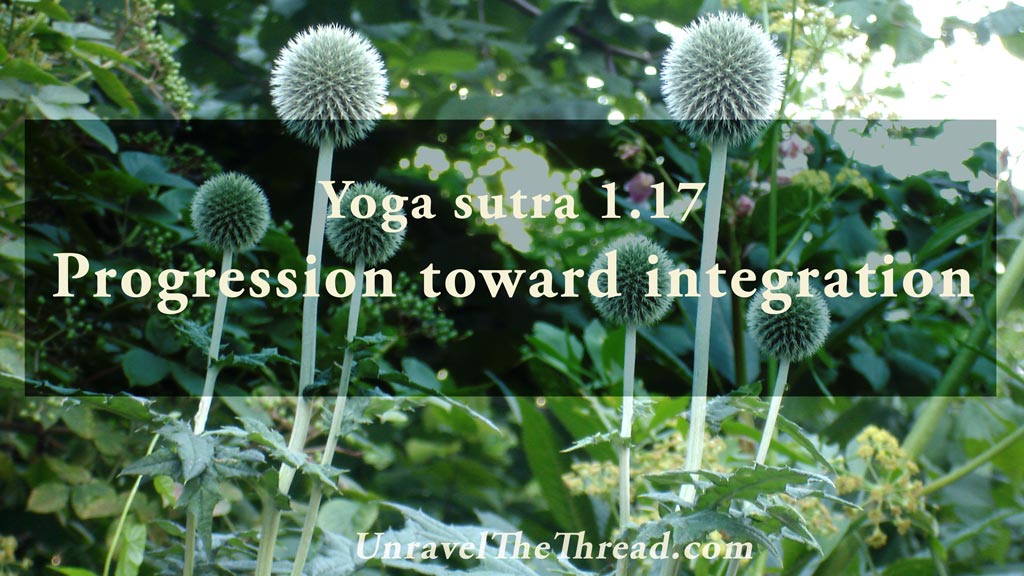
1.16: Awareness of Truth
July 28, 2019
1.18 Integration beyond higher wisdom
August 10, 2019
1.16: Awareness of Truth
July 28, 2019
1.18 Integration beyond higher wisdom
August 10, 20191.17: Progression to deep integration


1.17 A gradual progression towards deep inner integration (samprajñata samadhi) develops through subtle refinement of attention from reasoning (vitarka), to contemplation (vichara), to joy (ananda) and then to the sense of being (asmita).
This verse presents the process of moving towards deep integration, samadhi. This high level of integration is presented by Patañjali in two sutras, 1.17 and 1.18. Towards the end of Chapter One, Patañjali elaborates on the subtle details related to these two types of integration. The first type, explained in this verse is samprajñata samadhi, integration with higher wisdom. As with all things in nature, and in life, nothing develops overnight. Everything is a process, moving from one step to the next in an organic manner. For example, if you want to grow your own mango tree in your backyard, it makes sense to find out the most suitable variety of mango for your climate. Then you will need to make sure that there is enough space in the backyard to accommodate a mango tree of that variety. Then, it would be useful to go to your local nursery to get advice about the best soil preparation and times for planting. Next, you can get a seed or a sapling that you would need to plant and water as necessary. However, having planted your seed does not mean that you can go in the garden the next day to pick a ripe mango. It will take time for the tree to develop and mature so that it can produce flowers and then, when some of those flowers are pollinated they may transform into potential mangoes. Each step needs to happen at the right season and eventually, if you are lucky, after some time passes you may get some delicious mangoes right in your backyard.
Similarly, there is an organic process towards deeper levels of integration. As you saw in the previous verses, the process begins by removing distractions through establishing a clear intention and by committing your actions to your intention (abhyasa). You complement your practice by releasing attachments (vairagya) so that all your systems work in harmony facilitating a steady focus. Free from distractions, you choose a focal point to contemplate (vitarka), then your attention moves towards the subtler essence of that object or idea (vichara). At this level of subtlety, the mind is delighted, illuminated by its own stillness and silence (ananda). Beyond that level, you feel your own sense of self, or your sense of “I” in relation to the focal point chosen. These stages are the finer aspect of an even mind (samadhi). Rather than a reasoning process, this is a progression into refining your pure direct experience. Since it is not a thinking process, it is beyond the mind and thus impossible to represent fully with words. And, if you have to decide if you are in one of those states, that is already an indication that you are not. It truly is an organic process, it cannot be forced.
It makes sense that the twofold strategy of commitment and detachment is presented immediately before this idea of complete integration (samadhi), because it is exactly that balanced practice without attachment to the results (vairagya) that is most useful in moving towards this deeper level of integration. Moreover, relinquishing all attachments is what makes it possible to keep moving towards deeper levels of direct experience, because it will be necessary to let go of everything you think about. Furthermore, the previous sutra indicated that directing your attention towards Truth, the everlasting ground of existence where all the changes in life take place, removes all distractions and distractedness. Letting go of constant internal commentary enables you to remain focused and gain a deeper experience of whatever object or idea you concentrate on. Eventually, you experience directly and with increasing clarity your own individual sense of aliveness. Just like the sun is not changed by the clouds in the atmosphere, your fundamental essence (being or individual aliveness) is not changed by your activities (doings or becomings). This verse points out a gradual refinement of your connection to the sense of aliveness within you. Remember, that your sense of aliveness is always within you. However, your sense of individual aliveness sometimes gets obscured by the activities, labels and opinions in your internal space of awareness. The experience of integration (samadhi) introduced in this verse is the gradual process of refining your perception to experience life as it is.
One possible way of exploring this sutra is by focusing on one of your senses from its outward expression into its internal individual experience. For instance, when you are about to take a sip of water, you can slow down the perceptive process by pausing and focusing fully, with your eyes closed, on the contact between the water and your lips. Possibly some ideas about water will enter your space of awareness. Let them flow. Then, focus on the sensations as best as you can. Then feel the sensations of water on your inner mouth, teeth, gums and tongue. Instead of loading the experience with words or concepts, stay with the sensations in your mouth until you swallow the water as slowly as possible. Then stay with the very faint sensations lingering in your mouth. Notice what is happening, including any subtle processes being triggered, like related thoughts, feelings, emotions or memories. What is the subtlest aspect of the experience? Does the experience illuminate with awareness your sense of being? Is the subtlest aspect of water highlighting your own subtle sense of aliveness? This whole process is wordless and indescribable. You can try this approach systematically with each one of the senses, noticing where each takes you. Obviously, choosing an inspiring and meaningful focal point is more likely to be uplifting.
As you engage in this exercise, the internal distractions will offer hints uncovering beliefs and ways of being that are active and have not been released yet. Remember, that this process of internal integration (samadhi) happens after the inner talk has subsided. Thus, if you are still dealing with internal commentary, choose to drop the internal dialogue. Patient persistence is essential to drop internal activity, especially because your ways of being tend to be deeply entrenched. This is where the skill of returning again and again without strain, struggle or self-judgment is helpful. On the other hand, the experience of being is at the core of who you are, you are always connected to it. In fact, you cannot unplug from it. The practice is letting go of the ways of being that tend to take over your space of awareness. One of those ways of being is the need to comment constantly on the experience of just being. What do you find when you try this exploration? How does this experience contribute to te quality of your presence?
As usual, one more way of exploring the meaning of this sutra is by chanting it.
You can choose to chant it in its traditional form with some of the words coming together:
वितर्कविचारानन्दास्मितारुपानुगमात्संप्रज्ञातः ॥१७॥
vitarkavicārānandāsmitārupānugamātsaṃprajñātaḥ
Another option is to chant each word in the sutra individually:
- vitarka
- vicāra
- ānanda
- asmitā
- rupā
- anugamāt
- saṃprajñātaḥ
Unravel the thread is now available as a book!
If you find Simple-Yoga.org and Unravel the thread useful, consider supporting my labor with a donation, you may also donate using PayPal or Venmo. Thank you!